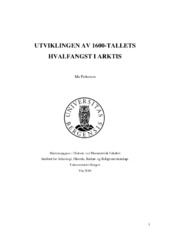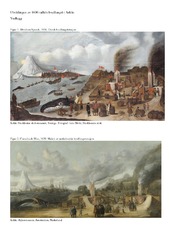| dc.description.abstract | This thesis is on the development of Arctic whaling in the 17th century. It deals with the question of how and why arctic whaling practice changed during the 17th century. Paintings, illustrations and maps have been used as “new” historical sources, as have Dutch newspapers from the era. The main development in 17th century whaling was a transition from shore-based to ocean-based whaling, where ships followed the whales along the edge of the ice. This happened gradually around the middle of the century. The industry aimed to produce the best possible whale oil in an economical way, which meant that it had to evolve when circumstances changed in the course of the century. Whalers had to adapt ships, equipment and techniques to the changing ice conditions and extent of the whale populations. Earlier research has been ambiguous when discussing the impact of climate change on the development of the whaling industry. It has been argued that the transition to ocean-based whaling occurred as a result of a colder climate, when large quantities of ice blocked access to land stations. At the same time, it has also been argued that in the years when the ice retreated, the whalers were forced to move away from the land stations in search of whales, who found their food along the edge of the ice. Elements of both shore-based and ocean-based whaling often coexisted and ice conditions sometimes varied greatly from year to year. This thesis concludes that the main reason for the transition from shore-based to ocean-based whaling most likely is the flexibility that the ocean-based whaling could show in meeting the challenges that changes in ice conditions and whale populations presented, as opposed to the more static land-based whaling. This thesis also shows that the categories shore-based and ocean-based whaling do not fully reflect the development of the whaling practice throughout the century. 17th century whaling went through several stages. The whaling technique used in the Arctic was founded on Basque expertise but developed to fit new circumstances. To begin with land stations were provisional arrangements, but from the 1620s they evolved into more advanced and permanent seasonal settlements on Spitsbergen and Jan Mayen. From the 1630s onwards, ocean-based whaling occurred further and further from land, and new whaling grounds were found along the ice edge around Greenland. Effective organization, and effective whaling and processing methods, as well as good ships and equipment, helped give the Dutch whalers an advantage over their rivals and competitors in the industry. | en_US |

